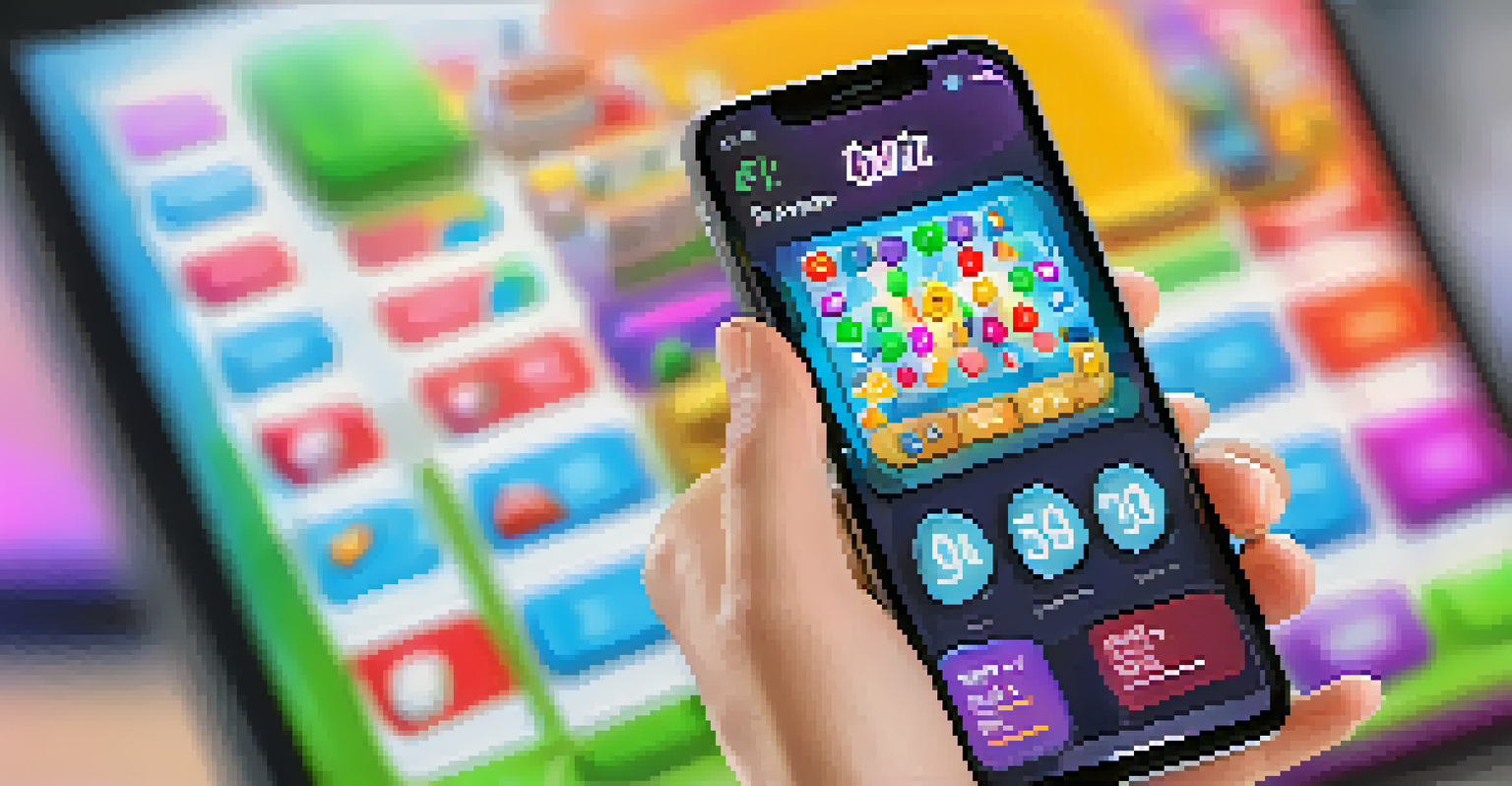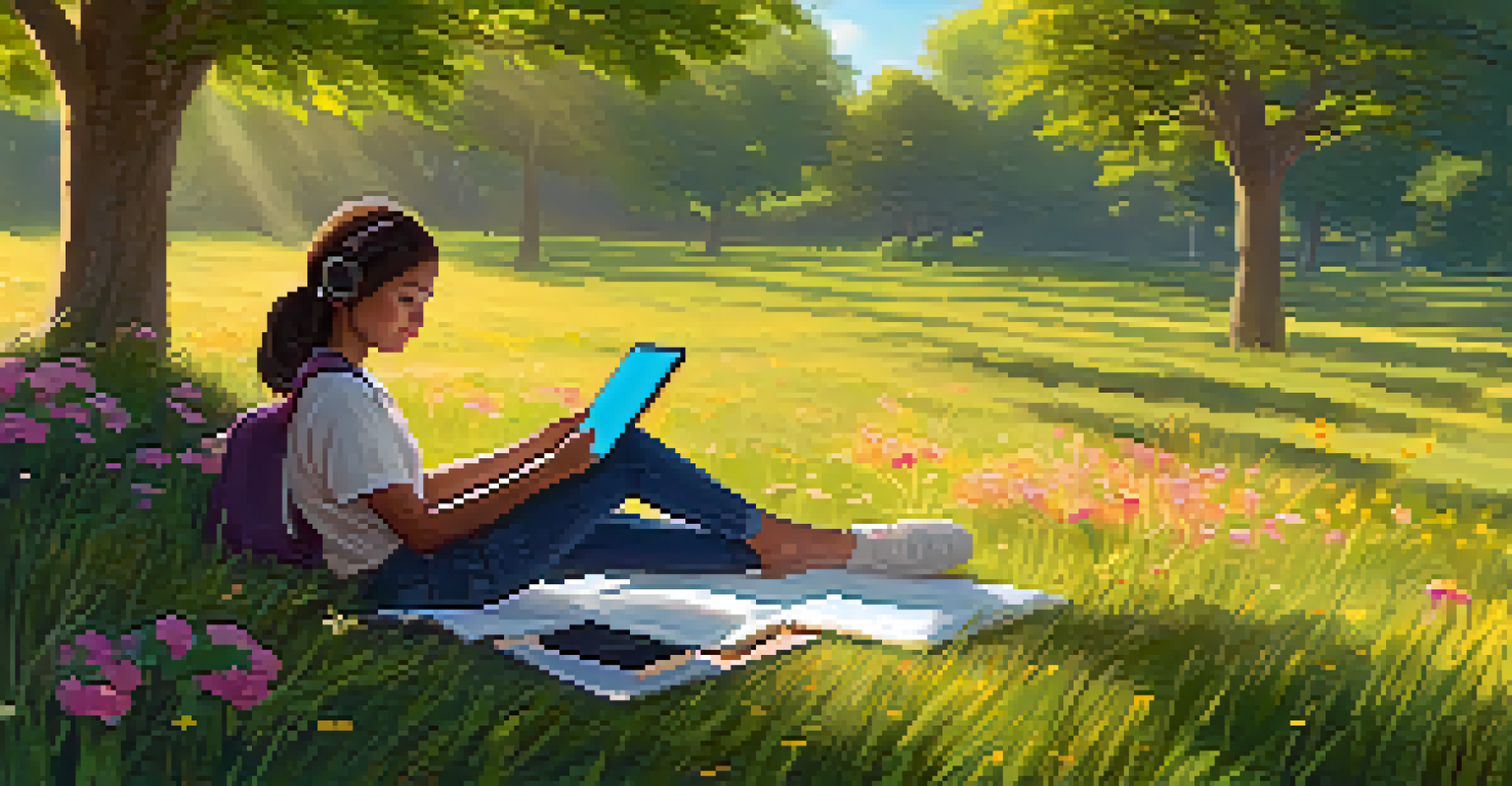Mobile Learning: Supporting Creativity in Education

Understanding Mobile Learning in Education
Mobile learning, often referred to as m-learning, involves using mobile devices to access educational content anytime and anywhere. This flexibility makes learning more accessible, particularly for students who may struggle in traditional classroom settings. By leveraging smartphones, tablets, and laptops, educators can create dynamic learning experiences that engage students in ways that static resources cannot.
The ability to learn faster than your competitors may be the only sustainable competitive advantage.
The rise of mobile learning has been fueled by technological advancements and the proliferation of internet connectivity. With nearly everyone carrying a smartphone, educational resources are just a tap away, bridging the gap between formal and informal learning. This shift not only supports academic achievement but also encourages lifelong learning, a crucial skill in today's fast-paced world.
Moreover, mobile learning's interactive nature allows for the incorporation of various multimedia elements, such as videos, podcasts, and interactive quizzes. These tools can stimulate creativity and critical thinking, helping students to engage more deeply with the material. In essence, mobile learning transforms the traditional educational experience into something much more vibrant and engaging.
Enhancing Creativity Through Mobile Apps
There are numerous mobile apps specifically designed to boost creativity in learning environments. For instance, platforms like Canva or Adobe Spark enable students to create stunning visuals for their projects right from their phones. These tools simplify complex tasks and encourage students to express their ideas in innovative ways, fostering artistic skills that may not flourish in a conventional classroom.

In addition to design apps, many educational games and simulation tools offer engaging ways for students to approach problem-solving creatively. Games that require strategic thinking or role-playing can stimulate imaginative responses and original thought. By integrating these applications into the curriculum, educators can turn learning into an exciting adventure that students look forward to.
Mobile Learning Enhances Accessibility
Mobile learning provides students with the flexibility to access educational content anytime and anywhere, making learning more inclusive.
Furthermore, collaboration apps allow students to work together on creative projects, regardless of their physical location. Platforms like Google Docs or Padlet enable real-time collaboration, promoting teamwork and creativity. This not only enhances their learning experience but also equips them with skills essential for the modern workforce.
Fostering Collaboration with Mobile Learning
Mobile learning inherently promotes collaboration among students, encouraging them to share ideas and resources easily. When students can connect through their devices, they can collaborate on projects, share feedback, and engage in discussions that enhance their understanding. This collaborative environment nurtures creativity as students learn from one another’s perspectives and experiences.
Education is the most powerful weapon which you can use to change the world.
For example, using social media platforms in educational settings can inspire students to share their creative works and get constructive criticism from peers. Platforms like Instagram or TikTok can serve as outlets for showcasing projects, allowing students to gain confidence in their abilities while receiving valuable input. This kind of interaction can spark new ideas and creative avenues that students may not have considered otherwise.
Moreover, mobile learning encourages diverse collaboration by connecting students from different backgrounds and cultures. This exposure to varied viewpoints can lead to richer discussions and innovative solutions to problems. Ultimately, collaboration through mobile learning not only enhances creativity but also prepares students for global citizenship in an increasingly interconnected world.
Engaging with Interactive Content
Interactive content is a powerful tool in mobile learning that captivates students’ attention and fosters creativity. This can include quizzes, polls, and interactive videos that require active participation, making learning more enjoyable. When students engage with content rather than passively consuming it, they are more likely to think critically and creatively.
For instance, platforms like Kahoot! allow educators to create fun quizzes that can be played on mobile devices. This gamified approach not only makes learning more engaging but also encourages friendly competition among students. As they strive to perform well, they're motivated to think creatively about the material being tested.
Creativity Boosted by Mobile Apps
Mobile applications enable students to engage in creative projects and collaborative experiences, enriching their learning journey.
Additionally, tools that incorporate augmented reality (AR) or virtual reality (VR) can transport students to different environments where they can explore concepts creatively. Imagine a biology class where students can interact with 3D models of cells right on their devices. Such immersive experiences can significantly enhance understanding and creativity, making abstract concepts tangible.
Personalized Learning Pathways Through Mobile Devices
One of the standout features of mobile learning is its ability to provide personalized learning experiences tailored to individual student needs. With mobile devices, students can progress at their own pace, exploring topics that interest them while reinforcing their understanding of core subjects. This autonomy fosters a sense of ownership over their education, inspiring greater creativity in how they approach learning.
For example, platforms like Khan Academy offer personalized learning journeys where students can select topics that resonate with them. This flexibility allows them to dive deeper into subjects they are passionate about, encouraging them to explore and create projects related to those interests. Such tailored experiences can ignite a spark of creativity that might otherwise remain dormant.
Moreover, personalized feedback through mobile learning apps can help students refine their creative skills. When educators provide targeted support based on individual progress, students gain insights that allow them to improve. This ongoing dialogue between students and educators helps cultivate a growth mindset, which is essential for creative development.
Overcoming Challenges in Mobile Learning
While mobile learning offers exciting opportunities for creativity, it also presents challenges that educators must navigate. Issues such as screen time management, digital distractions, and unequal access to technology can hinder the effectiveness of mobile learning initiatives. Addressing these challenges is crucial to ensure that all students can benefit from the creative potential of mobile devices.
For instance, educators can promote healthy screen time habits by encouraging students to balance their mobile learning with offline activities. Setting clear guidelines for device usage during lessons can help minimize distractions and maintain focus. By creating a structured approach, students can engage creatively without feeling overwhelmed by their devices.
Personalized Learning Empowers Students
Mobile devices facilitate personalized learning pathways, allowing students to explore topics at their own pace and fostering ownership of their education.
Furthermore, ensuring equitable access to technology is vital for fostering creativity in all students. Schools can implement programs to provide devices to students who lack access at home, leveling the playing field. When every student has the tools they need, creativity can flourish across diverse learning environments.
The Future of Mobile Learning in Creative Education
As technology continues to evolve, the future of mobile learning looks promising, particularly in supporting creativity in education. Innovations like artificial intelligence and machine learning could further personalize learning experiences, adapting to each student's unique needs and interests. This adaptability can inspire even more creative exploration as students engage with content that resonates with them.
Moreover, as mobile technology becomes more advanced, the integration of features like voice recognition and natural language processing could enhance interaction with educational content. Imagine students creating projects through voice commands or receiving real-time feedback on their ideas. This level of interactivity could ignite unprecedented levels of creativity and enthusiasm for learning.

In conclusion, the potential for mobile learning to support creativity in education is immense. By embracing these technologies, educators can create vibrant, engaging learning environments that inspire students to think outside the box. As we move forward, the focus must remain on harnessing these tools to cultivate creativity and prepare students for a future where innovation is key.